How to Feed & Maintain your Sourdough Starter
You’ve done it! You’ve created a living batter filled with wild yeast. Now let’s see how to feed & maintain your sourdough starter.
If you haven’t made your starter yet, visit this post to see how to make a sourdough starter from scratch.
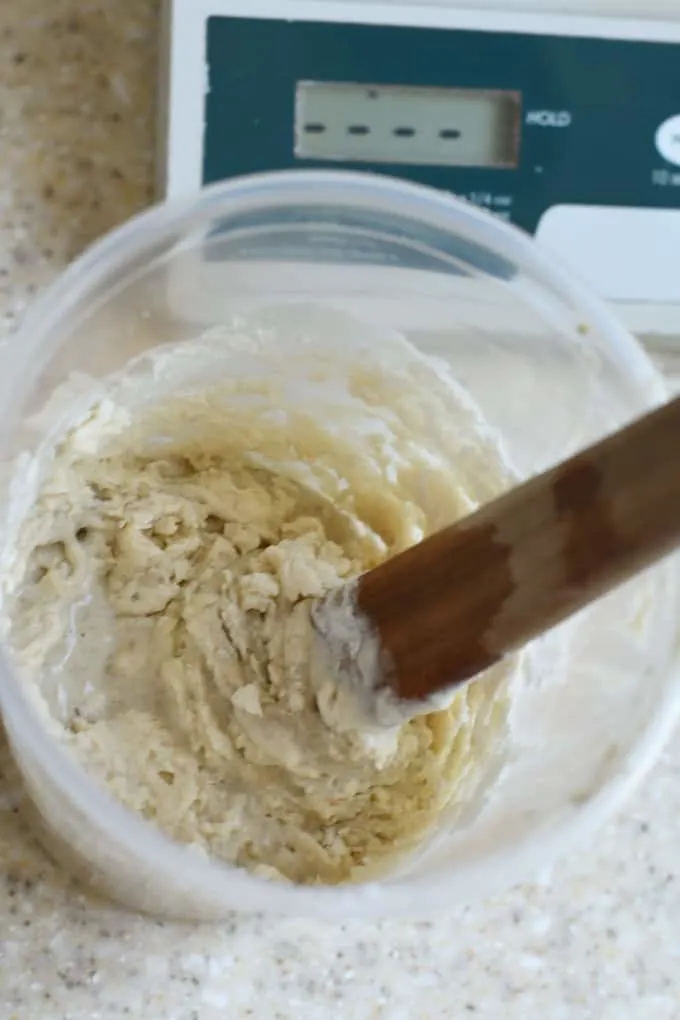
Right off the bat I’m going to say that there are a million ways to feed, maintain and use a sourdough starter. In fact, after you’re done reading this post, you should read through my instructions for How to keep a small sourdough starter to see of that method would work better for you.
I am going to outline for you how I maintain my sourdough starters. I tend to have a fairly relaxed attitude towards the process. It works for me and I think my approach can work for you if you don’t bake bread every single day (and even if you do).
At the end of the post you’ll find a how-to card that lists the ingredient amounts and steps to follow each time you feed your starter.
But first I’m going to give you all the how’s and why’s and try to answer any questions you might have.
Tips for using and maintaining your sourdough starter:
- Since I don’t bake every day, I keep my starters (yes, I have 3) in the refrigerator.
- If I’m making a 2-day recipe (most of mine are) I take the starter out of the refrigerator early in the morning of the day I’m making the dough. If the starter is inactive I feed it right away and it should be ready by early afternoon.
- If I’m making a 1-day recipe, I’ll take the starter out the night before and feed it if it’s inactive. It should be ready to use first thing in the morning.
- When the starter is cold from the refrigerator, I feed the starter using fairly warm water, warmer than body temp. The warm water will jump-start the cold starter.
- If the starter has been fed within the last 2-3 days, and has been refrigerated, you can probably go ahead and use it without feeding.
- If you’re not sure if the starter is active, drop a dollop into a bowl of water to see if it floats. If it does, it’s ready for baking.
- I write all my sourdough recipes to use 8 oz of active starter. After using 8 oz of starter in the recipe, I’m left with 4 oz of starter, exactly the right amount for feeding.
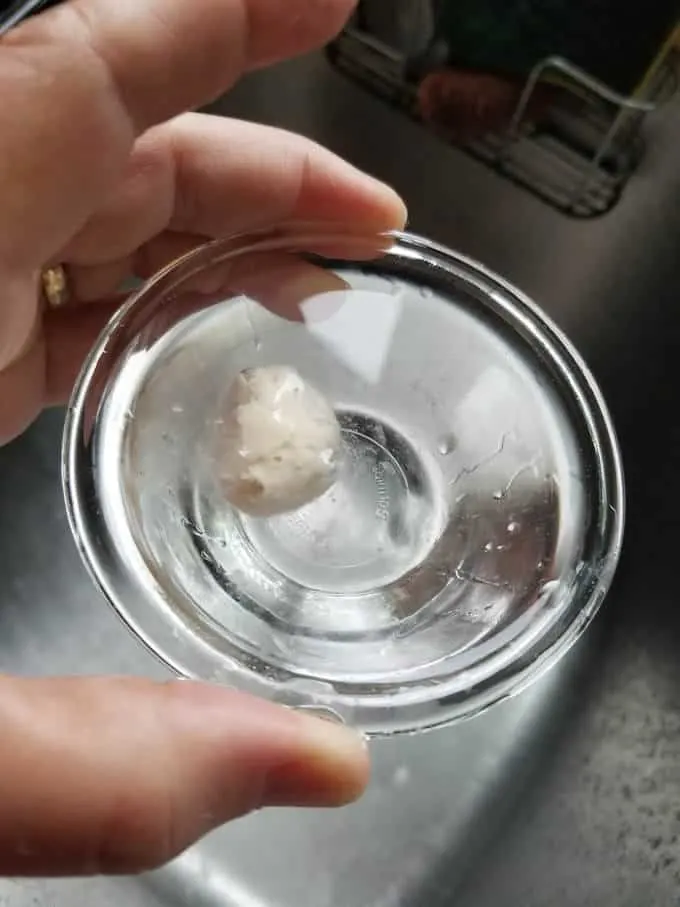
Schedule for feeding your sourdough starter:
- Your starter needs to be fed about 1x per week if refrigerated, and every day if left at room temperature.
- Generally, about 5-6 hours after feeding my starter is ready. The time may vary based on room temp, dough temp, etc. The starter should have doubled in volume and started to recede and/or pass the float test.
- I take my starter out of the refrigerator once a week for feeding, even if I’m not baking. Although, truth be told, I often go longer than a week between feedings and I haven’t killed it yet.
- Did you know you can dry your sourdough starter? Dried starter can be kept indefinitely.
- After you’ve removed the portion of starter for baking, feed the starter again and leave it at room temperature for 3-4 hours before putting it back in the refrigerator.
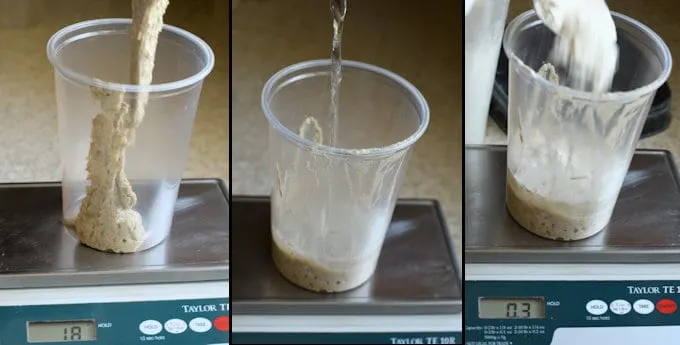
FAQs about feeding & maintaining Sourdough Starter:
Honestly, I’ve gone longer than a month without feeding my starter and I haven’t killed it yet. Give it a feeding and see if it wakes up. If it’s alive, keep feeding it until it is reliably doubling in size within 4-5 hours.
If you go more than about 2 weeks between feedings, you might want to give the starter 2-3 feedings before using. A starter that hasn’t been fed for weeks will be quite sluggish and your dough won’t be as lively.
If your starter was fed a day or two before, it’s possible to use the starter straight from the refrigerator. Give it a float test to make sure it’s active. The dough may take a little longer to ferment since the temperature of the dough will be colder.
It’s called “hooch” and don’t worry, your starter is still alive. Just stir that water back into the starter before feeding. Again, you might need 2 feedings to completely revive the starter since it’s been quite dormant.
To maintain your starter at 100% hydration it is best and most accurate to weigh your ingredients. If you’re just a little bit off every time you feed, eventually, your starter could be thrown out of balance.
No problem, use the amount of starter called for in the recipe. Then weigh out 4 oz of the remaining starter for feeding and discard the rest.
If you continually feed the starter without discarding, you’ll end up drowning in starter.
Yes, even if the discard is not active enough for baking bread, you can add it to many other recipes as a flavor and texture enhancer.
Unless you’re going away for an extended time, your starter should be just fine for a couple of weeks in the refrigerator. If you’ll be gone really long-term, put the starter into the freezer or dry it. Frozen or dried starter will need several feedings to rejuvenate.
If you appreciate this detailed information, I’d really appreciate a 5-star review.
How to Feed Sourdough Starter
Ingredients
- 4 oz unfed sourdough starter
- 4 oz all purpose flour
- 4 oz water (room temperature)
Instructions
- Weigh 4 oz of your unfed starter into a clean container. Discard the extra starter (see note)4 oz unfed sourdough starter
- Add the flour and water and mix until combined. Set aside at room temperature.4 oz all purpose flour, 4 oz water
- The starter is ready to use when it has doubled in volume and a small spoonful floats when dropped into a bowl of water. This generally takes 4-5 hours but the time can vary based on dough temperature and room temperature.
- If you do not plan to bake with the starter on the day it is fed, refrigerate 3-4 hours after feeding.
- Feed refrigerated starter weekly. If you go longer than a week without feeding, you may want to give the starter two feedings before using.
Would you like to save this recipe?
As an Amazon Associate and member of other affiliate programs, I earn from qualifying purchases.

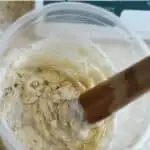





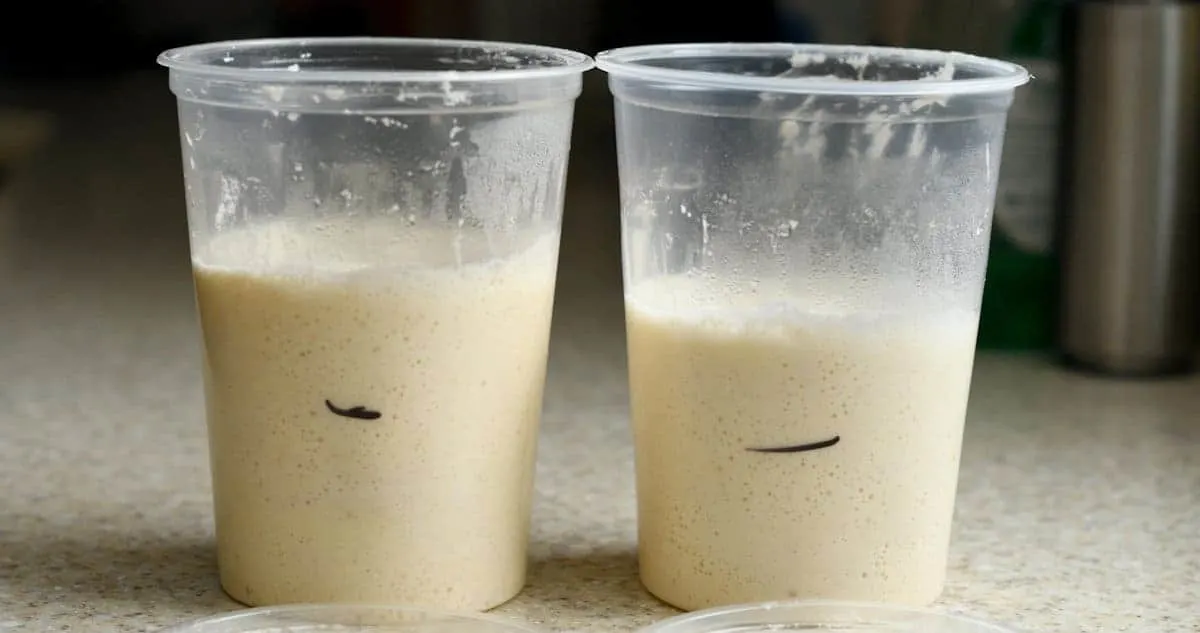
I really appreciate your information it answered most of my questions on keeping and using sourdough.
We are going away for a few weeks and I was wanting to put my starters in the freezer (I have two, one regular and one wheat free for my wheat-allergic daughter). When do I put it in the freezer? Should I feed, let it rise like normal, and then put it in that day? Or wait a few days, maybe until the night before we leave? And when we get back, do I thaw it and feed it right away? Or thaw for a few days in the fridge first? I also need to have a look at drying some of it, but that might be better left until we get back and I have time to make sure I understand it properly (my luck, I’d mess it all up!)
How long are you away? Honestly, I’ve left my starters for a month (and more) and have no problem reviving them. If you feed the starters just before you leave and feed them as soon as you get back I don’t think you should have any problem. If the starter is very sluggish upon return you could give it 2 feeding before baking with it. You could dry some of the starter or discard as a backup. This all applies to the wheat starter. Not having experience with wheat free starter I can’t speak from experience. But I’d bet you’d have the same results if the starter has a similar activity cycle as the wheat starter.
@Eileen Gray, we will be gone 3 weeks, but it would be probably 4 weeks between feeds if I follow my normal feeding day. Trying not to cram all the possible “things to do” into the day before we leave because it drives my husband crazy when I do that! I usually keep the starters pretty small (1/2 oz of each part for feeds) but I suppose I could do the full amount that is in each jar. The wheat free one might be on a different cycle because it never seems to have the same consistency/texture as the other one. I’ve never thought to give it a different time though…might try that this weekend! Thanks!
I have a question. I have a 7week old starter. been on counter. been feeding twice a day and using it to bake.
when can I put in fridge. I have read 3 to 4 months. I am soo ready to put in fridge.
please get back to me.
thank you
I started putting mine in the fridge right after they were ready. Sourdough starters are much less fussy than some would lead you to believe. I suggest taking out of the fridge and feeding 1x per week if you can. But, honestly, I’ve gone more than a month without feeding (refrigerated) and haven’t killed a starter yet. Also, if you’ve got lots of discard you can dry drying the discard rather than tossing it.
You mentioned 100% hydration as being equal ants by weight. Are there other hydration’s? What are they used for?
You could keep a thicker starter by using more flour than water by weight or a thinner starter with more water than flour by weight. Obviously a stiffer starter will yield a stiffer dough and a wetter starter will yield a moister dough. There are more factors involved, such as the temperature you keep the starter at and how frequently you feed. But generally a lower hydration starter (stiffer) tends to produce a bread with more acetic acid which has more of the tangy, vinegary flavor. A more liquid starter will tend to produce more lactic acid, or milky, flavor. Again, this is not a straight forward result. How you handle a starter from hydration to feeding frequency to holding temp will affect the final loaf. I develop my recipes with a consistent process of temperature, hydration and feeding to try and keep the results consistent for readers. But you can experiment with all the factors to make your perfect loaf.
How do I add feed to the Starer before taking of for baking? I am almost left with nothing !
I’m not sure exactly what your question is. Did you read through the post and instructions? You feed 4 oz of starter with 4 oz of water and 4 oz of flour. When that is ready and active you can use the amount of starter called for in your recipe. Then feed the starter again to bring it back to the starting weight (12 oz). Feeding, using and refeeding the starter is a cycle.